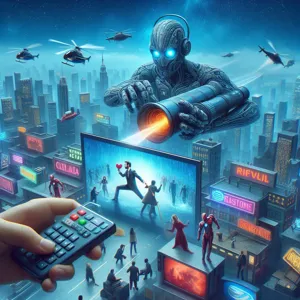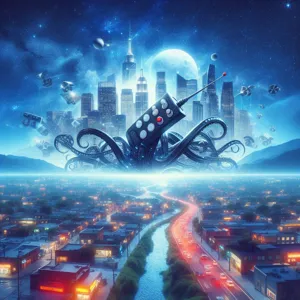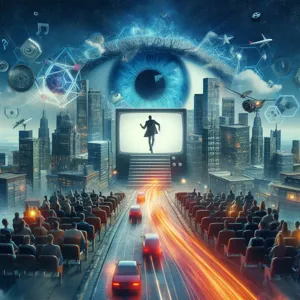In an era where instant gratification reigns supreme, the way we consume movies has undergone a seismic shift, transforming our viewing habits and redefining the cinematic experience.
Gone are the days of crowded theaters and rigid schedules; today, streaming platforms have placed a world of entertainment at our fingertips, allowing us to curate our own movie nights with unparalleled convenience. From binge-watching entire seasons of gripping dramas to discovering hidden gems from international filmmakers, the streaming revolution is reshaping not only what we watch but how we connect with storytelling itself. In this blog post, we delve into the profound impact of streaming on our movie experience, exploring the rise of subscription services, the democratization of content creation, and the evolving relationship between audiences and filmmakers in this dynamic digital landscape. Get ready to immerse yourself in the reel revolution and discover how it is changing the way we enjoy cinema in the comfort of our homes.
1. Introduction: The Rise of Streaming Services

In recent years, the cinematic landscape has undergone a seismic shift, with streaming services emerging as the dominant force in how we consume films and television shows. Gone are the days when families would gather around the television, waiting eagerly for the weekly airing of their favorite shows or making a trip to the local video rental store on a Friday night. Today, with the click of a button, a world of content is available at our fingertips, 24/7, transforming the way we experience storytelling.
The rise of platforms like Netflix, Hulu, Amazon Prime Video, and Disney+ has changed the dynamics of the entertainment industry, reshaping viewer habits and expectations. Viewers are no longer bound by rigid schedules or geographical limitations; they can binge-watch entire seasons in a single weekend or discover hidden gems from global filmmakers without ever leaving their couch. This newfound convenience has not only made it easier for audiences to access a diverse array of content but has also fostered a culture of on-demand viewing, where consumers dictate what they watch and when they watch it.
Moreover, the impact of streaming services extends beyond mere accessibility. These platforms are revolutionizing the types of stories being told. With the ability to invest in original content, streaming services have become incubators for innovative storytelling, giving voice to underrepresented creators and pushing the boundaries of traditional genres. This democratization of content has led to a rich tapestry of films that reflect a multitude of perspectives, resonating with audiences worldwide.
As we delve into this transformative era of entertainment, it’s essential to explore how streaming services are not just reshaping our viewing habits but also redefining the very essence of the movie experience. From the way films are produced and marketed to how audiences engage with content, the ripple effects of this shift are profound and far-reaching. Join us as we navigate through this reel revolution, uncovering the myriad ways in which streaming is changing our relationship with cinema.
2. A Brief History of Movie Consumption
To understand the profound impact of streaming on our movie experience today, it’s essential to take a step back and traverse the rich history of movie consumption. The journey begins in the late 19th century with the advent of the motion picture, where cinema was a communal experience. The first movie theaters, often referred to as nickelodeons, offered short films that captivated audiences, igniting a passion for storytelling on the silver screen.
As the decades rolled on, the introduction of sound in the late 1920s revolutionized the industry, turning silent films into immersive narratives filled with dialogue and music. The golden age of Hollywood emerged, characterized by lavish productions and star-studded casts, drawing millions into theaters across the globe. The experience of watching a movie became an event—complete with popcorn, soda, and the anticipation of what was to come.
Fast forward to the arrival of television in the 1950s, which began to reshape home entertainment. Families gathered around their screens, often tuning in to weekly shows or movie specials, fostering a new dynamic of viewing experiences. The 1980s brought about the VCR, granting audiences the power to watch films on their own terms, paving the way for a more personalized viewing experience.
As technology continued to advance, so did the methods of consumption. The introduction of DVDs in the late 1990s and the rise of rental services like Blockbuster transformed how we accessed films, allowing viewers to curate their own movie nights without the constraints of theater schedules. However, it wasn’t until the 21st century that a seismic shift occurred with the birth of streaming services.
Platforms like Netflix, Hulu, and later Disney+ turned the movie-watching landscape on its head, allowing audiences to binge-watch entire series or explore vast libraries of films from the comfort of their homes. Suddenly, the ability to watch what you want when you want became the norm, creating a culture of instant gratification that altered our relationship with cinema forever.
Streaming has not only increased accessibility but has also democratized content creation. Independent filmmakers now have the opportunity to reach global audiences without the need for traditional distribution channels, fostering a diverse array of voices and stories that were previously marginalized.
As we examine this evolution from communal theaters to solitary screens, it’s clear that the way we consume movies has fundamentally changed. Streaming has redefined our movie experience, enabling a new era of viewing that prioritizes convenience, personalization, and diversity. With each significant leap in technology, the film industry continues to adapt, setting the stage for what comes next in this ongoing reel revolution.
3. The Impact of COVID-19 on Movie Watching Habits

The COVID-19 pandemic has left an indelible mark on nearly every aspect of our lives, and the world of cinema is no exception. As theaters shuttered their doors and public gatherings became a thing of the past, audiences turned to their screens at home for solace and entertainment. This dramatic shift catalyzed a transformation in movie-watching habits that is likely to resonate long after the pandemic has subsided.
With the lockdowns in full effect, streaming platforms surged in popularity, becoming the primary source of film consumption for many. Traditional moviegoers, who once relished the communal experience of a theater, began to embrace the intimacy and convenience of home viewing. No longer constrained by schedules or the need to travel, audiences discovered the freedom of binge-watching entire series or catching the latest blockbuster from the comfort of their own couches. This shift not only altered viewing habits but also expanded the type of content that viewers sought. Audiences became more adventurous, exploring indie films, international cinema, and niche genres that they may have overlooked in theaters.
The pandemic also accelerated the trend of simultaneous releases—where films premiere on streaming services and in theaters at the same time. Major studios, initially hesitant, quickly adapted to this new landscape, recognizing that audiences were eager for immediate access to new releases without the wait. The result has been a rich tapestry of content available at our fingertips, transforming the traditional movie release model into a more flexible and dynamic experience.
As we navigate the post-pandemic world, the impact of COVID-19 on movie-watching habits is undeniable. Viewers have grown accustomed to the convenience of streaming, and as theaters reopen, many may opt for the comfort of home rather than the communal experience of the big screen. This evolution in our movie experience signifies not just a change in viewing preferences, but a broader cultural shift in how we engage with storytelling and entertainment. The reel revolution is here, and it has forever altered the landscape of our cinematic journey.
4. Streaming vs. Traditional Cinema: A Comparative Analysis
In an era where the lines between entertainment mediums blur, the clash between streaming services and traditional cinema has become a hotbed for discussion among film enthusiasts and casual viewers alike. The debate is not merely about preference; it encapsulates a broader shift in how we consume content and experience storytelling.
### Accessibility and Convenience
One of the most significant advantages of streaming is its unparalleled accessibility. With just a few clicks, viewers can explore vast libraries of films and series from the comfort of their own homes. Gone are the days of planning a night out to see a movie; now, audiences can choose from a plethora of options available at any time, whether it’s a new blockbuster or a hidden indie gem. This convenience allows viewers to watch what they want, when they want, and how they want—whether that’s binge-watching an entire season or savoring a classic over a cozy weekend.
### The Communal Experience
In contrast, traditional cinema offers something streaming cannot replicate: the communal experience of watching a film with others. The shared laughter, gasps, and collective emotional responses create a unique atmosphere that enhances the storytelling experience. The large screen, surround sound, and the ritual of heading out to a theater contribute to a sense of occasion that can transform a simple movie night into a memorable event. For many, the thrill of seeing a new release on opening night, surrounded by fellow fans, is an irreplaceable part of movie culture.
### Cost Considerations
Cost is another factor that shapes the streaming versus cinema debate. Subscriptions to streaming services often come at a fraction of the price of a single movie ticket, making it a more economical choice for regular viewers. However, this does not account for the additional costs associated with going to the cinema—snacks, transportation, and parking can quickly add up. For families or groups, the cost of a cinema outing can be prohibitive, further tipping the scale in favor of at-home viewing.
### Quality of Experience
While streaming technology has advanced significantly, allowing for high-definition viewing on various devices, there remains a certain quality that many cinephiles argue is best enjoyed on the big screen. The grandeur of a cinematic experience, with its larger-than-life visuals and immersive sound, can elevate a film from a mere story to an unforgettable spectacle. Filmmakers often design their work with theater viewing in mind, employing techniques that enhance the experience of a full audience.
### The Future of Film Consumption
As we navigate this evolving landscape, it’s clear that both streaming and traditional cinema have their merits and unique appeal. While streaming offers convenience and accessibility, traditional cinema provides a communal experience that many still cherish. The future of film consumption may not lie in a definitive winner of this debate, but rather in a harmonious coexistence that allows audiences to choose their preferred method of experiencing the magic of movies, ensuring that the art of storytelling continues to thrive in whatever form it takes.
5. The Role of Original Content in Streaming Platforms

In the ever-evolving landscape of entertainment, original content has emerged as a game-changing pillar for streaming platforms, redefining the way we consume movies and series. Unlike traditional networks that often rely on existing films and shows, streaming services like Netflix, Amazon Prime Video, and Disney+ have boldly ventured into the realm of original programming, creating a vast array of unique stories that cater to diverse tastes and interests.
The allure of original content lies not only in its exclusivity but also in its ability to captivate audiences with fresh narratives and innovative storytelling. From gripping dramas and lighthearted comedies to groundbreaking documentaries and animated features, these platforms are curating a rich tapestry of content that often challenges conventional norms. Take, for instance, the meteoric rise of shows like “Stranger Things” or “The Mandalorian,” which have not only garnered critical acclaim but have also sparked cultural phenomena, driving conversations beyond the screen and into our daily lives.
Moreover, original content allows streaming services to create an emotional connection with viewers, often fostering a sense of loyalty that traditional networks struggle to maintain. By producing series and films that resonate with specific demographics, platforms can build a dedicated following that eagerly anticipates each new release. This commitment to original storytelling also enables them to attract top-tier talent—renowned directors, writers, and actors—eager to push creative boundaries and explore new storytelling avenues.
Additionally, the investment in original content is a strategic move to combat the growing competition within the industry. As more players enter the streaming arena, standing out becomes crucial. Platforms that can deliver compelling, high-quality original films and series not only enhance their brand identity but also create a unique selling proposition that keeps subscribers engaged and enticed to stay.
In conclusion, the role of original content in streaming platforms is not just about filling a catalog; it’s about reshaping the cinematic experience itself. By prioritizing originality, these services are not only redefining how we watch movies but are also setting the stage for a new era of storytelling that is as dynamic as it is diverse. As the lines between cinema and streaming continue to blur, one thing is clear: original content is here to stay, and it’s revolutionizing the way we experience film.
6. How Streaming Services are Changing Film Distribution
The advent of streaming services has fundamentally transformed the landscape of film distribution, reshaping how movies are released, marketed, and consumed. Gone are the days when a film’s success hinged solely on its theatrical release; today, studios have a multitude of distribution avenues at their disposal, allowing for a more nuanced approach to reaching audiences.
Streaming platforms like Netflix, Hulu, and Amazon Prime Video have democratized access to films, enabling viewers to enjoy a diverse array of content from the comfort of their own homes. This shift has empowered filmmakers, offering them the opportunity to bypass traditional distribution hurdles often dictated by major studios. Independent films, once relegated to niche audiences, can now find a global platform, connecting with viewers who seek fresh and diverse storytelling.
Moreover, the timing of releases has undergone a significant overhaul. The once-sacrosanct window between theatrical premieres and home video releases has shrunk dramatically. Films can now debut directly on streaming platforms, often simultaneously with their theatrical launches, or shortly thereafter. This flexibility not only caters to the growing audience preference for on-demand viewing but also allows studios to capitalize on the buzz generated during film festivals or award seasons.
The data-driven nature of streaming services also plays a crucial role in this revolution. Platforms analyze viewer habits and preferences, enabling them to tailor marketing strategies and even shape future productions based on audience demand. This insight can lead to the creation of niche content that might have previously gone unnoticed in traditional distribution models.
In summary, streaming services are not just changing how we watch movies; they are redefining the entire film distribution ecosystem. As filmmakers and studios adapt to this new reality, audiences are reaping the benefits of greater access to a wider array of films, ultimately enriching our collective movie experience.
7. The Global Reach of Streaming: Breaking Geographic Barriers

In an era where the world feels increasingly interconnected, streaming services have emerged as a powerful force in breaking down geographic barriers that once defined our viewing experiences. Gone are the days when movie lovers were limited by the availability of films in their local theaters or the selection on physical media. Now, a treasure trove of global cinema is just a click away, allowing audiences to explore diverse cultures, stories, and artistic expressions from the comfort of their homes.
The global reach of streaming platforms such as Netflix, Amazon Prime Video, and Disney+ has transformed the landscape of film consumption. These services not only provide a vast library of content but also invest heavily in local productions, ensuring that their offerings resonate with audiences around the world. For instance, a gripping thriller from South Korea, a heartwarming drama from Nigeria, or a comedic series set in Brazil is just as accessible as a Hollywood blockbuster, inviting viewers to broaden their horizons and embrace international storytelling.
Moreover, streaming services often feature multilingual options, including subtitles and dubbing, making it easier for viewers to engage with content in languages they may not speak. This inclusivity fosters a sense of global community among audiences, as films and series that once might have gone unnoticed now find their way into the hearts and minds of viewers from different backgrounds.
The ripple effect of this accessibility is profound. Filmmakers from all corners of the globe now have a platform to share their unique perspectives and experiences, leading to a richer, more varied cinematic landscape. As audiences flock to these diverse offerings, they not only enjoy entertainment but also develop a deeper understanding and appreciation for cultures beyond their own.
In this age of the streaming revolution, the world is truly at our fingertips, transforming how we consume and connect with cinema. As geographic barriers continue to dissolve, the possibilities for storytelling and cultural exchange are limitless, paving the way for a more inclusive and vibrant film industry that celebrates the richness of our shared human experience.
8. Changing Audience Preferences: Binge-Watching Culture
In the age of streaming, audience preferences have undergone a seismic shift, giving rise to what is now commonly known as binge-watching culture. Gone are the days when viewers patiently awaited weekly episodes of their favorite shows; today, entire seasons are often released in one fell swoop, inviting audiences to indulge in marathon viewing sessions. This new paradigm has transformed how we consume stories, with many finding themselves lost in the immersive worlds of their favorite series for hours on end.
Binge-watching allows for deeper engagement with narratives, enabling viewers to become fully invested in character arcs and plot developments without the interruption of weekly cliffhangers. The freedom to pause, rewind, and replay scenes fosters a more personalized and interactive experience, creating a unique bond between the viewer and the content. This shift has also influenced the storytelling techniques employed by creators, who now craft narratives that are designed to hook audiences from the start and maintain their interest through multiple episodes.
Moreover, the communal aspect of viewing has evolved as well. While binge-watching can be a solitary experience, streaming platforms have harnessed this trend by incorporating features that allow users to share their viewing habits with friends or join virtual watch parties. This blending of personal and social viewing experiences has created a new kind of fandom, where discussions and theories flourish online, often extending the life of a show far beyond its original run.
As streaming services continue to dominate the entertainment landscape, understanding and adapting to the binge-watching culture is crucial for filmmakers and marketers alike. It’s not just about creating great content anymore; it’s about crafting a viewing experience that resonates with a generation of viewers who crave instant gratification and immersive storytelling. In this ever-evolving landscape, the rules of engagement have changed, and those who can harness the power of binge-watching will undoubtedly find themselves leading the charge in the reel revolution.
9. The Effects of Streaming on Movie Quality and Production
The rise of streaming services has transformed the way we consume films, but it has also significantly impacted movie quality and production. As platforms like Netflix, Amazon Prime, and Disney+ become mainstays in our entertainment diet, filmmakers are adapting to a new landscape that demands both volume and innovation.
One of the most notable effects of streaming is the democratization of content creation. Independent filmmakers now have unprecedented access to audiences without the traditional gatekeeping of Hollywood studios. This shift has led to a surge in diverse storytelling, as creators from various backgrounds find their voices amplified on these platforms. It’s not uncommon to discover hidden gems or avant-garde films that might have struggled to secure a theatrical release. As a result, we are witnessing a broader spectrum of narratives and perspectives, enriching the overall cinematic tapestry.
Moreover, streaming services are often willing to take risks on unconventional projects that traditional studios might shy away from. This willingness to experiment has led to innovative storytelling techniques and bold artistic choices, elevating the quality of content being produced. Series like “The Queen’s Gambit” and films such as “Roma” and “The Irishman” showcase how streaming can foster high-caliber productions with significant budgets, talented casts, and visionary directors at the helm. These projects not only push the boundaries of what we expect from films but also raise the bar for future productions.
However, this rapid production pace can also lead to a saturation of content, where quantity sometimes overshadows quality. With countless titles released weekly, the challenge for viewers becomes sifting through the noise to find truly exceptional works. The pressure to produce more content can result in rushed projects that lack the polish and depth audiences crave. Additionally, the focus on algorithms and viewer metrics can inadvertently steer filmmakers toward formulaic storytelling, as the pursuit of virality often trumps originality.
In summary, while streaming has undeniably enriched our movie experience by broadening access and encouraging creativity, it also poses challenges that require careful navigation. As audiences, we must remain discerning, supporting quality narratives that uplift the art of film while enjoying the plethora of options at our fingertips. The ongoing evolution of streaming continues to redefine our expectations, setting the stage for an exciting future in the world of cinema.
10. The Future of Theatrical Releases in a Streaming World
As we delve into the future of theatrical releases in an increasingly streaming-centric world, it becomes clear that the landscape of cinema is evolving at an unprecedented pace. The once-sacrosanct separation between the silver screen and home viewing is blurring, reshaping how we experience films and redefining the very essence of movie-going.
In this new era, it’s not just about the convenience of clicking a button to watch the latest blockbuster from the comfort of your couch; it’s about the rich tapestry of experiences that streaming platforms are weaving into the fabric of film consumption. With platforms like Netflix, Amazon Prime, and Disney+ investing heavily in original content, the traditional model of theatrical releases is facing significant challenges. Major studios are reevaluating their strategies, opting for simultaneous releases that allow audiences to choose between watching in theaters or at home.
However, the theater experience still holds a unique allure—there’s a magic in the communal atmosphere, the immersive sound, and the grand visuals that simply can’t be replicated at home. As a result, many filmmakers and studios are exploring hybrid models, where select films receive a theatrical release for a limited time before transitioning to streaming platforms. This approach aims to capture the excitement of the big screen while also embracing the flexibility that streaming offers.
Moreover, the emergence of exclusive streaming premieres is signaling a new chapter for independent filmmakers. With fewer financial barriers to entry, more diverse voices are finding their way to audiences. The accessibility of streaming gives rise to new narratives that may have struggled to find footing in traditional theaters, enriching the cinematic landscape as a whole.
As we look to the future, the question arises: will the theater experience become a cherished ritual for special events, or will it fade into the background as streaming continues to dominate? One thing is certain—the dialogue between theaters and streaming platforms will shape the next generation of storytelling, offering viewers a broader array of choices and experiences than ever before. In this reel revolution, the only constant is change, and the movie experience is poised to become even more dynamic and engaging.
11. The Role of Data Analytics in Content Creation and Recommendations
In the rapidly evolving landscape of streaming, data analytics has emerged as a powerful tool that shapes not only how content is curated but also the very essence of what gets produced. Gone are the days when studios relied solely on gut feelings or traditional box office trends to dictate their creative strategies. Today, every click, pause, and rewind is meticulously tracked, providing invaluable insights into audience preferences and viewing habits.
Streaming platforms harness vast amounts of data to analyze what genres captivate viewers, which actors draw in audiences, and even the optimal length for a binge-worthy episode. For instance, if analytics reveal that audiences are particularly drawn to sci-fi thrillers featuring strong female leads, you can bet that studios will prioritize projects that align with these insights. This data-driven approach not only fuels the creation of content that resonates with viewers but also ensures a more tailored viewing experience.
Moreover, data analytics plays a crucial role in recommendations, creating a personalized journey for each subscriber. By analyzing past viewing behavior, platforms can suggest new titles that align with individual tastes. This enhances user engagement, as viewers are more likely to find content that captivates them, which in turn fosters loyalty to the platform. The algorithms working behind the scenes are constantly learning and evolving, adapting to changes in viewer preferences almost in real-time.
In this age of information, the integration of data analytics into content creation and recommendations is revolutionizing the movie experience, making it more immersive and personalized than ever before. As streaming services continue to refine their analytical capabilities, we can expect a future where the line between viewer and creator blurs, allowing audiences to influence the very fabric of the entertainment landscape.
12. Challenges Facing the Streaming Industry
As the streaming industry continues to grow and reshape our movie-watching experience, it faces a unique set of challenges that could impact its future trajectory. One of the most pressing concerns is the sheer saturation of the market. With an ever-increasing number of platforms vying for consumers’ attention, audiences can feel overwhelmed by the plethora of choices. Whether it’s Netflix, Hulu, Disney+, Amazon Prime Video, or the latest niche service, consumers may struggle to determine which subscriptions are worth their time and money. This fragmentation can ultimately lead to subscription fatigue, pushing viewers to reconsider their streaming options and potentially disconnect altogether.
Another significant challenge is content saturation. While streaming services continually churn out original content to attract subscribers, the quality of that content can vary greatly. As viewers become more discerning, the pressure on platforms to deliver high-quality, engaging material intensifies. Too often, platforms may prioritize quantity over quality, resulting in a flood of mediocre films and series that fail to resonate with audiences. This can not only frustrate viewers but also lead to dwindling engagement and subscription cancellations.
Additionally, the streaming industry faces fierce competition from traditional media, such as cinema and cable television. While streaming has revolutionized how films are consumed, the allure of the big screen experience remains strong for many. Cinematic releases offer a communal and immersive experience that streaming cannot fully replicate. This tension between the two formats raises questions about how streaming services can evolve to coexist with traditional media rather than merely replace it.
Moreover, piracy remains a persistent threat to the streaming landscape. Despite various measures taken to combat illegal distribution, pirated content continues to circulate online, undermining the revenue potential for legitimate services. As consumers seek free alternatives, the viability of subscription models becomes increasingly precarious, prompting platforms to innovate and find new ways to protect their content while still appealing to audiences.
Lastly, the technological divide cannot be overlooked. While streaming is accessible to many, a significant portion of the global population still struggles with reliable internet access. This disparity creates a barrier for potential viewers and limits the growth of streaming services in underserved regions. As the industry looks to expand its reach, addressing these technological challenges will be crucial to ensure inclusivity and accessibility for all movie lovers.
In conclusion, while streaming has undeniably transformed our movie experience, it must navigate these challenges to sustain its growth and continue delivering the captivating content that audiences crave. Adapting to an evolving landscape will be key to ensuring the streaming revolution continues to thrive in the years to come.
13. The Impact of Streaming on Independent Filmmakers
The rise of streaming platforms has significantly transformed the landscape for independent filmmakers, offering both unprecedented opportunities and unique challenges. Gone are the days when indie films struggled to find a place in crowded theaters or faced insurmountable barriers to entry in traditional distribution channels. Now, platforms like Netflix, Amazon Prime Video, and Hulu provide a direct line to audiences, democratizing the film industry and allowing diverse voices to be heard.
For independent filmmakers, streaming services have become a lifeline, enabling them to showcase their stories to a global audience without the need for a hefty budget or a major studio’s backing. This accessibility means that filmmakers can produce unique and unconventional narratives that might not fit the mold of mainstream cinema. As a result, viewers are treated to a rich tapestry of storytelling that includes everything from gritty documentaries and experimental shorts to heartwarming dramas and bold comedies.
However, this newfound accessibility comes with its own set of challenges. The sheer volume of content available on streaming platforms can make it difficult for indie films to stand out in a crowded marketplace. Filmmakers must now be savvy marketers, leveraging social media, influencer partnerships, and targeted advertising to cut through the noise and reach potential viewers. Additionally, the revenue model for streaming can be less favorable for independent creators compared to traditional theatrical releases, prompting many to grapple with how to monetize their work effectively.
Despite these hurdles, the impact of streaming on independent filmmakers is undeniably profound. It has fostered a renaissance of creativity and innovation, allowing filmmakers to take risks and explore themes that resonate with niche audiences. In this new era, independent films are not just surviving; they are thriving, often sparking conversations and movements that challenge cultural norms. As streaming continues to evolve, it will undoubtedly play a critical role in shaping the future of cinema, paving the way for a more inclusive and diverse film industry that reflects the myriad voices of our society.
14. Conclusion: What’s Next for the Movie Experience?
As we stand at the intersection of technological advancement and storytelling innovation, the future of the movie experience is brimming with possibilities. The rise of streaming platforms has not just transformed how we consume content; it has redefined the very essence of cinematic storytelling. No longer confined to the walls of a theater, films now have the potential to reach audiences across the globe, fostering a more diverse and inclusive environment for storytelling.
Looking ahead, we can anticipate a few key trends shaping the movie experience in the coming years. First, the integration of interactive content is likely to deepen viewer engagement, allowing audiences to become active participants in the stories they consume. Imagine a world where viewers can influence plot directions or character decisions—this level of interactivity could revolutionize the traditional viewing experience.
Moreover, advancements in virtual reality (VR) and augmented reality (AR) will likely continue to blur the lines between the real and the imagined. Picture donning a VR headset and stepping into a scene from your favorite film, where you’re not just a spectator but part of the narrative itself. As technology becomes more accessible, filmmakers will have the opportunity to create immersive worlds that captivate audiences like never before.
Additionally, the focus on personalized viewing experiences is expected to grow. With the wealth of data available to streaming services, recommendations can be tailored to individual tastes, ensuring that each viewer is presented with content that resonates with them. This level of customization could lead to a more intimate relationship between viewers and the stories they choose to embrace.
Lastly, the communal aspect of movie-watching will evolve. While streaming allows for solitary viewing, the future may see a resurgence of shared experiences through virtual watch parties or interactive screenings, bridging the gap between physical and digital spaces. As we navigate this new landscape, the essence of storytelling remains at the forefront, driving the connection between creators and consumers.
In conclusion, the movie experience is on the cusp of a revolution, fueled by technology and the ever-evolving desires of audiences. As we embrace these changes, one thing is certain: the magic of cinema will continue to captivate and inspire, offering new ways to escape into the stories we love. The future holds exciting prospects, beckoning us to explore what lies ahead in this dynamic realm of entertainment.
15. Call to Action: Engaging with the Future of Film
As we stand at the crossroads of a cinematic renaissance, the future of film beckons us to engage, explore, and innovate. Streaming platforms have not only transformed how we consume content but have also democratized the filmmaking process, offering a vibrant playground for both creators and audiences alike. This is your call to action: become an active participant in this unfolding narrative.
Start by immersing yourself in the wealth of diverse stories available at your fingertips. Seek out independent films and international features that push boundaries and challenge conventional storytelling. Subscribe to platforms that prioritize original content, and support emerging filmmakers by sharing their work within your networks. Your voice as a viewer can amplify the visibility of these narratives and foster a richer cinematic landscape.
Moreover, consider contributing to the dialogue surrounding film. Engage with online communities, join discussions, and share your insights on social media. Your thoughts can spark conversations that shape the industry’s trajectory. Attend virtual film festivals or Q&A sessions with filmmakers to gain deeper insights into their creative processes.
For those inspired to take a more hands-on approach, why not explore your own filmmaking aspirations? With user-friendly technology and affordable editing software, creating and sharing your own stories has never been more accessible. Start small—perhaps with a short film or a documentary project—and share it through the very platforms that have redefined our viewing habits.
As we embrace the evolution of cinema, remember that the future is not just something we witness; it’s something we actively shape. By engaging with the stories that resonate with you, supporting creators, and amplifying diverse voices, you play an integral role in the thriving ecosystem of film. Let your passion for cinema guide you into this exciting new era, and together, let’s redefine our movie experience.
As we conclude our exploration of the “Reel Revolution,” it’s clear that streaming is more than just a trend; it’s a transformative force reshaping the very essence of our movie-watching experience. From the convenience of on-demand access to a diverse array of genres and global stories, streaming platforms have democratized cinema, allowing us to discover hidden gems and embrace different cultures from the comfort of our homes. The shift towards personalized viewing, coupled with innovative storytelling techniques, has forged a new kind of engagement that traditional theaters struggle to replicate. As we move forward, it’s exciting to imagine how this evolution will continue to influence filmmakers, audiences, and the industry as a whole. Whether you’re a casual viewer or a dedicated cinephile, the next chapter in our cinematic journey promises to be dynamic and full of surprises. So, grab your popcorn, explore those streaming libraries, and prepare to embrace the future of film in all its captivating forms!






